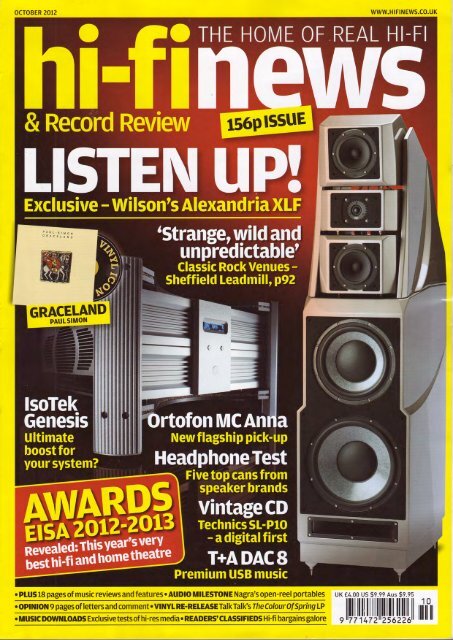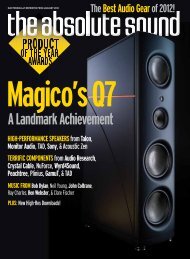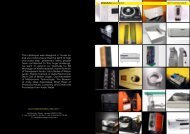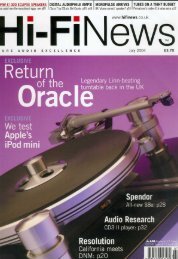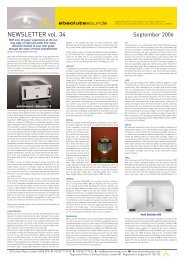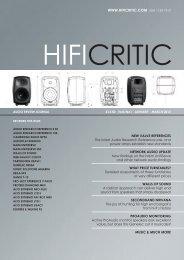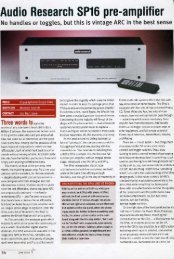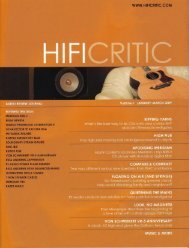loudspeaker - Absolute Sounds
loudspeaker - Absolute Sounds
loudspeaker - Absolute Sounds
You also want an ePaper? Increase the reach of your titles
YUMPU automatically turns print PDFs into web optimized ePapers that Google loves.
LOUDSPEAKER<br />
Wilson Audio<br />
Alexandria XLF (£200k)<br />
Inspired by the Alexandria, Wilson’s latest flagship is its<br />
grandest yet. Is the XLF audio’s defining statement?<br />
Review: Keith Howard, Ken Kessler & Paul Miller<br />
It seems like only yesterday but it<br />
is actually getting on for a decade<br />
since Wilson Audio launched its new<br />
flagship model, the Alexandria, in<br />
2003. Four years later came the<br />
Series 2, on which basis Wilson Audio<br />
watchers will have been expecting a<br />
further enhancement to appear around<br />
now. But the Alexandria XLF is not a<br />
replacement for the S2. It is, in fact,<br />
an adjunct to it: physically larger and<br />
‘measurably more ambitious’, thereby<br />
supplanting the S2 as the best speaker<br />
Wilson Audio now makes, even though the<br />
S2 remains available.<br />
It’s not as if its older sibling lacked in<br />
visual presence – not only because of its<br />
size but as much for<br />
its angular, sci-fi-film<br />
appearance – but the<br />
XLF is even bigger,<br />
even more inclined to<br />
dominate anything but<br />
the largest of domestic<br />
rooms. With a 14% hike<br />
in the internal volume<br />
available to its twin bass drivers, the<br />
XLF stands almost 1.8m tall and comes<br />
within a tantalising 2.9kg of weighing 0.3<br />
tonnes each. ‘Wilson Audio has always<br />
rejected the notion of perceived value’,<br />
says the website, but nobody with pockets<br />
deep enough to afford the XLF will ever<br />
complain it is physically underwhelming.<br />
In its essentials, the XLF is obviously<br />
of the same bloodline as the S2. It sports<br />
twin bass drivers of different diameter – an<br />
arrangement which, Wilson says, is difficult<br />
to tune, but when done correctly results<br />
in faster transients both objectively and<br />
subjectively – above which the familiar<br />
faceted D’Appolito midrange-tweetermidrange<br />
array covers the bulk of the<br />
audible frequency range and is minutely<br />
adjustable to provide accurate time<br />
alignment at the distance and seated<br />
ear height chosen by its owner. Within<br />
‘It takes a week of<br />
eight-hour shifts to<br />
CNC machine all<br />
the pieces’<br />
www.hifinews.co.uk | Reprinted from Hi-Fi News & RR<br />
this familiar framework, though, some<br />
important things have changed.<br />
DOwn THE SILK ROAD<br />
Of these the most surprising – even in a<br />
world where many speaker manufacturers<br />
no longer subscribe to the idea that metal<br />
dome tweeters are a sine qua non – is the<br />
substitution of a silk dome tweeter for the<br />
inverted titanium dome that has become<br />
something of a Wilson Audio trademark.<br />
Exactly what decided Dave Wilson on a<br />
root and branch review of the tweeter<br />
design is unclear but he and his team<br />
looked at all the hi-tech dome materials<br />
now in use – including diamond, beryllium<br />
and alumina – before rejecting them in<br />
favour of an apparently<br />
prosaic alternative.<br />
One key issue here<br />
was the fact that<br />
Wilson’s 7in midrange<br />
driver, originally<br />
seen in the Series 2,<br />
can’t reach up to the<br />
2.5-3kHz crossover<br />
frequency typically employed, presumably<br />
because of cone breakup, and perhaps<br />
directivity, issues. Traditionally Wilson<br />
Audio doesn’t quote crossover points or<br />
slopes but it’s clear from its description<br />
of the new tweeter that it has to be able<br />
to operate down to around 1.2kHz, an<br />
octave or so lower. This in turn means<br />
that the Wilson tweeter has to have a<br />
low fundamental resonance frequency,<br />
something which militates against the use<br />
of low-mass dome materials, whose effect<br />
is to increase it.<br />
A second issue was Dave Wilson’s<br />
long-standing concern with what he<br />
RIGHT: Wilson’s XLF has twin bass drivers<br />
(13in and 15in), twin 7in midranges and twin<br />
1in tweeters, one rear-firing, just like the<br />
Alexandria S2 – but a new silk dome tweeter<br />
replaces the familiar inverted titanium dome<br />
Floorstanding four-and-a-half-way <strong>loudspeaker</strong><br />
Made by: Wilson Audio Specialties, Utah, USA<br />
Supplied by: <strong>Absolute</strong> <strong>Sounds</strong> Ltd<br />
Telephone: 0208 971 3909<br />
Web: www.wilsonaudio.com; www.absolutesounds.com
GEnESIS OF THE XLF<br />
Last year, I was afforded the privilege of visiting the Wilson factory<br />
in Provo, Utah, when I became the first ‘outsider’ to hear the ‘nearly<br />
finished’ XLF side-by-side with the Alexandria. It was a test not<br />
only of one’s listening ability but of one’s capacity for dealing with<br />
differences that were neither better nor worse… just dissimilar. A<br />
direct descendant of the WAMM and its time alignment capabilities,<br />
the XLF was designed to extract even more from the Alexandria<br />
concept, while adding greater room matching flexibility thanks to<br />
a choice of rear or front ports. While hearing the side-by-side demo,<br />
I was impressed as much by the still-stunning performance of the<br />
Alexandria as I was by the seemingly subtle gains in the XLF. The<br />
session with the final XLF? Revelatory. KK<br />
refers to as the tweeter’s ‘noise<br />
floor’ – which, as I’d always supposed<br />
but have now had confirmed, is<br />
actually a reference to the speed<br />
of energy decay. Key to achieving a<br />
fast decay is careful absorption of<br />
the rear radiation from the dome<br />
so, like its predecessor, the new<br />
tweeter incorporates a damped<br />
rear chamber, which also reduces<br />
the stiffness of the enclosed air and<br />
so helps with keeping down the<br />
tweeter’s fundamental resonance<br />
frequency. Wilson’s literature doesn’t<br />
say so explicitly but it’s reasonable<br />
to suppose that the weightier silk<br />
diaphragm also helps suppress the<br />
effect of what little rear-radiated<br />
energy remains.<br />
InTEnSIvE LAbOUR<br />
Dave Wilson makes frequent<br />
reference to ‘dynamic contrast’<br />
and ‘harmonic expression’ when<br />
describing the qualities he strives<br />
for in his <strong>loudspeaker</strong>s, and in both<br />
respects the new Convergent Synergy<br />
tweeter is said to be an improvement<br />
over its predecessor. In addition, and<br />
perhaps not unrelated, it is claimed<br />
to have a flatter on-axis response,<br />
extending out to 33kHz, and bettercontrolled<br />
off-axis behaviour. Like the<br />
Series 2, the XLF also has a rear-firing<br />
tweeter, rolled in at about 15kHz,<br />
which adds extra treble ‘air’.<br />
The other major changes are at<br />
the opposite end of the frequency<br />
spectrum, in the bass. As already<br />
mentioned, the internal volume of<br />
the bass enclosure has increased by<br />
14%, despite which the XLF’s specified<br />
sensitivity has reduced by 1dB,<br />
although it still remains exceptionally<br />
high for a wide-bandwidth directradiating<br />
speaker, at 93.5dB. Wilson’s<br />
engineers have taken the opportunity<br />
of the revised cabinet dimensions to<br />
refine its complex construction still<br />
further, using laser interferometry<br />
to assess the results. As a result the<br />
cabinet is even more inert than<br />
the S2’s. You get some idea of the<br />
extensive vertical and horizontal<br />
cross-bracing used within from the<br />
CAD drawing on page 45, and from<br />
the fact that it takes a week of eighthour<br />
shifts to CNC machine all the<br />
pieces for just one enclosure.<br />
With over 500 pairs of Alexandria<br />
Series 2s now in the hands of owners<br />
around the world, Dave Wilson has<br />
had ample opportunity to hear the<br />
speaker working in a wide variety<br />
of rooms. It was as a result of<br />
noting that the S2 can sound a little<br />
bass-light in some environments –<br />
particularly where there is little soft<br />
furnishing acting as high frequency<br />
absorbent and the listening position<br />
is on the room centreline, where the<br />
null of the lowest width mode occurs<br />
– that he contrived the Cross Load<br />
Firing port system (which is what XLF<br />
stands for, not extra low frequency as<br />
you might have supposed).<br />
The concept is an essentially<br />
simple one – that the matching<br />
of the speaker to the room at<br />
low frequencies can be adjusted<br />
according to whether its reflex port<br />
exhausts forwards or backwards. So<br />
the XLF accommodates both options,<br />
by means of a removable panel and<br />
plug that can be used to block off<br />
the rectangular port mouth at either<br />
the front or rear of the enclosure. It’s<br />
a job of only a few minutes with a<br />
screwdriver to effect the change.<br />
KEn KESSLER LISTEnS<br />
A day with the Wilson XLFs, driven<br />
by darTZeel NHB-458 monoblocks:<br />
heady stuff for an intense listening<br />
Reprinted from Hi-Fi News & RR | www.hifinews.co.uk
LOUDSPEAKER<br />
AIR APPAREnT<br />
Speaker directivity has been a controversial issue for almost as long as<br />
<strong>loudspeaker</strong>s have been made. While some pundits have argued that only<br />
omnidirectional design can achieve ideal integration of <strong>loudspeaker</strong> and room,<br />
most speaker designers, over the gamut of prices from budget to stratospheric,<br />
persist in preferring the classical design model in which, as frequency rises,<br />
acoustic output is restricted to a narrowing cone as the wavelength in air<br />
becomes comparable to the dimensions of the driver diaphragm and cabinet.<br />
But a softening of this approach is now apparent in some high-end designs, like<br />
the Alexandria and the Sonus faber Aida, where rear-firing tweeters are used<br />
to ensure that reverberant sound in the room is less denuded of treble than it<br />
would otherwise be, adding extra ‘air’ to the speaker’s treble. These are typically<br />
rolled-in much higher in frequency than the forward-firing tweeter, and are often<br />
level-adjustable to suit different rooms, programme material and tastes. The<br />
effect, as Wilson Audio says of the Alexandria, ‘is subtle but quite audible.’ KH<br />
session. Armed with a gold CD I’d burned, I<br />
played track after killer track, the intention<br />
being to learn what Wilson’s new flagship<br />
could do with familiar material.<br />
All it took was the lowest notes of Barry<br />
White’s ‘Just the Way You Are’, the lead<br />
guitar break of the Elvin Bishop Band’s<br />
‘Fooled Around And Fell In Love’ and the<br />
kick drums on Bonnie Raitt’s ‘Standin’ By<br />
The Same Old Love’ to know that the XLF<br />
had it all. And that ‘all’ is ‘presence’.<br />
Initially, it was the scale that provided<br />
the convincing: even in a room that would<br />
qualify strictly as ‘mid-sized’, the XLFs<br />
created the deepest, broadest soundstage<br />
I have ever experienced, beyond that of<br />
Martin-Logan Statements and even the<br />
original ‘The Apogee’ – and those were<br />
heard in far larger rooms.<br />
But the overriding quality,<br />
the USP that makes this<br />
speaker so truly worthy<br />
of the correct use of the<br />
word ‘awesome’ is the<br />
sense of power it conveys.<br />
We tend to forget the<br />
basic rule of high-end<br />
audio and the definition of high fidelity: to<br />
reproduce music so accurately that you are<br />
fooled into thinking that you’re present at<br />
the original musical event. We have all had<br />
moments (certainly back in the 1960s... )<br />
when the sound was so plausibly real that<br />
we had to do double-takes.<br />
POSTER CHILD<br />
Through the XLF, it happens with far<br />
greater frequency than anyone could<br />
hope to experience. The way this speaker<br />
manages and directs intangibles like air<br />
and space, beyond the reproduction<br />
of the actual notes themselves, adds<br />
mightily to the realism. And at both ends<br />
of the spectrum: the sparse opening of<br />
Bobby Darin’s ‘Reason To Believe’, just<br />
‘It was a sublime<br />
minestrone of<br />
sound, seasoned<br />
to perfection’<br />
RIGHT: Mechanical adjustments allow the<br />
head assembly to be meticulously time-aligned.<br />
Precision resistors tune the tweeter level,<br />
midrange level and phase, and bass damping<br />
acoustic guitar, bass and light percussion,<br />
provided an opportunity to listen ‘into’<br />
the soundscape, the musicians enjoying<br />
an in-the-room 3D realism for which<br />
movie director James Cameron would<br />
kill. Conversely, the force felt from the<br />
hard-rocking band behind Tina Turner on<br />
‘Nutbush City Limits’ – if ever the word<br />
palpable had a poster child, then this is it.<br />
Undeniably, the XLF handles both the<br />
delicacy of Darin and the bombast of<br />
Turner with equal aplomb. The definitive<br />
‘convincer’, though, was the mass of the<br />
enormous orchestra<br />
behind Dean Martin<br />
on ‘Ain’t That A Kick In<br />
The Head’: room-filling,<br />
realistic, seamless and<br />
silky. It was a sublime<br />
minestrone of sound,<br />
seasoned to perfection,<br />
every ingredient<br />
balanced in ideal proportions.<br />
One cannot underplay the role of the<br />
darTZeels: their limitless grunt freed the<br />
XLF of any constraints. Song after song, I<br />
heard more, felt more than I thought this<br />
old hack would ever experience again, the<br />
XLFs handling the muscle of the darTZeels<br />
as does a Veyron chassis cope with its<br />
kilo-horses. I implore you, whether in the<br />
market for speakers this heady or not: find<br />
a way to hear the XLF and know what to<br />
strive for in your quest for realistic sound.<br />
PAUL MILLER LISTEnS<br />
Ken choose darTZeels for his session, I<br />
choose the Devialet D-Premier driven via a<br />
balanced AES/EBU digital connection with<br />
both CD and hi-res media. The combination<br />
of vice-like grip and absolute transparency<br />
offered by the D-Premier was not lost on<br />
the XLFs which responded in kind, carving<br />
out a soundfield that made even the<br />
fabulous Sonus faber Aidas [HFN Apr ’12]<br />
sound slightly ‘small’, lush and romantic.<br />
We might like to kid ourselves<br />
otherwise, but experience suggests that<br />
only a very large speaker has the capacity<br />
to ‘shape’ the body of a physically large<br />
instrument – be it piano, drum kit or<br />
double-bass – in realistic proportion.<br />
But even the B&W 802s that I use every<br />
day – grand by any normal measure – are<br />
dwarfed by the XLFs. And the scale of<br />
Reprinted from Hi-Fi News & RR | www.hifinews.co.uk
LOUDSPEAKER<br />
the performance follows suit, for<br />
these Wilsons, huge gulf in price<br />
notwithstanding, have the capacity<br />
to make other big speakers sound<br />
like miniatures. But the XLFs have<br />
another trick up their capacious<br />
sleeves: midband and vocalorientated<br />
recordings, lacking any<br />
real substantive bass, are focused<br />
with the precision of a supertransparent<br />
LS3/5a.<br />
The percussive edge of strings<br />
from Pat Metheny’s homage to<br />
The Beatles’ ‘And I Love Her’ had<br />
an exquisite bite, the voice truly<br />
lifelike. A contrasting string tone was<br />
revealed by Christy Moore’s ‘Reel<br />
In The Flickering Light’, a lighter,<br />
quicker and sharper presentation<br />
that was both more immediate<br />
and yet still intimate as the XLFs<br />
invited us to sit at the feet of the<br />
Irish lyricist. The rolling rhythm was<br />
truly infectious and by the time the<br />
percussion announced itself, no one<br />
in the listening room had motionless<br />
fingers or toes.<br />
In similar fashion, the clarity of<br />
the double-tracking from Eleanor<br />
LEFT: Construction of the enlarged<br />
bass cabinet has been refined to make<br />
it even more inert than that of the S2.<br />
CNC machining all the parts for just one<br />
cabinet takes a week<br />
McEvoy’s ‘What’s Her Name’ from<br />
Alone was revealed with forensic<br />
discipline, her voice gushing with<br />
liquid ease, supremely focused and<br />
unmistakably ‘real’.<br />
bLUE TOUCH PAPER<br />
It’s a sound that will hold you<br />
transfixed, not for its aural fireworks,<br />
although the XLF is more than<br />
capable of firing musical ordnance<br />
when required, but for its clarity, its<br />
insight into both the recording and<br />
the passion of the performer. It’ll<br />
sound relaxed with George Michael’s<br />
‘Jesus To A Child’, as delicious and<br />
rich as ’80s pop was ever scored,<br />
or as punchy and dynamic as you<br />
might care to experience. Listen to<br />
Fallulah’s Black Cat Neighbourhood<br />
by way of example and while the<br />
hand claps ricochet about at the<br />
edges of the soundstage, her voice<br />
is pinned to the centre and the bass<br />
is slammed into the room in broad,<br />
rhythmic brush strokes.<br />
While we are talking low<br />
frequencies, the synthesised bass<br />
from the psychedelic Skylab #1’s<br />
‘River Of Bass’ [AstralWerks ASW<br />
6161-2] roiled into the room, a<br />
palpable pressure building about us<br />
and moving body – if not soul – with<br />
the efficacy of the biggest active<br />
subwoofer, driven by the cleanest<br />
amplifier on this earth. What a<br />
sound! The XLF is so much more<br />
than a ‘loud speaker’ – it’s a portal<br />
to a new musical experience.<br />
HI-FI nEwS vERDICT<br />
Recognising milestones is a<br />
thankless pursuit. Miss one when<br />
it appears, and you’re deaf. Find<br />
too many, and you’re gullible.<br />
But we can feel it in our bones:<br />
the XLF raises sound quality to<br />
new levels. It is a game-changer.<br />
For neutrality, authority, scale<br />
and realism, the XLF is the<br />
most authentic speaker we’ve<br />
ever heard. It’s as big a leap in<br />
performance as the Quad ESL was<br />
in 1957. And that’s not hyperbole.<br />
Sound Quality: 94%<br />
0 - - - - - - - - 100<br />
LAb<br />
REPORT<br />
wILSOn ALEXAnDRIA XLF (£200k)<br />
Wilson Audio claims a high 93.5dB sensitivity for the Alexandria<br />
XLF but that figure is amply confirmed by our pink noise result<br />
of 93.8dB (200Hz-20kHz). This is achieved in part through<br />
low impedance but the XLF is not particularly challenging to<br />
drive, as some costly speakers are. Although our measured<br />
minimum impedance of 2.7ohm is lower than the 3.2ohm<br />
minimum claimed, impedance phase angles are – typically for<br />
Wilson products we’ve measured – low throughout the audible<br />
range with the result that the minimum EPDR (equivalent peak<br />
dissipation resistance) is 1.7ohm at a high 16.1kHz. Probably<br />
more relevant is the dip to 1.9ohm at 862Hz, either figure<br />
indicating that the XLF is a relatively benign amplifier load.<br />
Frequency response, measured at 1m on the tweeter<br />
axis, is principally characterised by a dip in output centred on<br />
2.5kHz, despite which the response errors 200Hz-20kHz are a<br />
modest ±3.9dB and ±4.2dB respectively for the pair [see Graph<br />
1, below]. Over the same frequency range, the pair matching<br />
error of ±1.1dB is fair but not exceptional. Diffraction-corrected<br />
near-field measurement showed the bass extension (–6dB re.<br />
200Hz) to be, for such a large speaker, disappointing at 50Hz<br />
but a kick-up lower in frequency suggests that 40Hz is probably<br />
a more realistic figure. Something still lower might be expected<br />
but remember the XLF’s high sensitivity. Ultrasonic response<br />
of the soft dome tweeter extends to beyond 40kHz but it’s<br />
unusual to see in the cumulative spectral decay waterfall a<br />
distinct albeit probably inaudible resonance at around 15kHz<br />
[Graph 2]. Otherwise the initial energy decay is quite fast but<br />
for some well-damped resonances in the lower treble. KH<br />
ABOVE: Very extended response from a supersensitive<br />
speaker, but note dips at 2.5kHz and 7.5kHz<br />
dB<br />
- 6<br />
- 12<br />
- 18<br />
- 24<br />
- 30<br />
200 1000 10000<br />
Frequency in Hz >><br />
HI-FI nEwS SPECIFICATIOnS<br />
0. 00<br />
Reprinted from Hi-Fi News & RR | www.hifinews.co.uk<br />
1. 02<br />
2. 04<br />
3. 06<br />
4. 08<br />
5. 10 msec<br />
ABOVE: Cabinet resonances are well controlled. There<br />
is just a hint of treble dome breakup at 15kHz<br />
Sensitivity (SPL/1m/2.83Vrms – Mean/IEC/Music) 94.0dB/93.8dB/93.3dB<br />
Impedance modulus min/max (20Hz–20kHz) 2.7ohm @ 20kHz<br />
7.7ohm @ 49Hz<br />
Impedance phase min/max (20Hz–20kHz) –26 o @ 204Hz<br />
29 o @ 1.2kHz<br />
Pair matching (200Hz–20kHz) ±1.1dB<br />
LF/HF extension (–6dB ref 200Hz/10kHz) 40Hz / >40kHz/>40kHz<br />
THD 100Hz/1kHz/10kHz (for 90dB SPL/1m) 0.2% / 0.5% / 0.3%<br />
Dimensions (HWD) 1784x504x708mm


